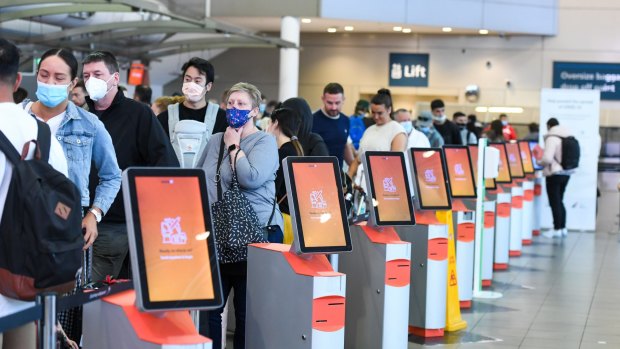This was published 2 years ago
Travel delays at airports over Easter holidays: Passengers aren't 'match fit'? Alan Joyce might be right
By Lee Tulloch

Passengers queue at Sydney Airport on Wednesday.Credit: Peter Rae
Scenes of chaos met travellers at Sydney airport's domestic terminals in the lead-up to the holidays. A reduced number of security lanes in the departure hall created a backlog, causing long lines of weary passengers to snake out of the buildings. Many missed their flights.
We've all been there before. Arriving at an airport, excited about the trip, only to find an unexpected bottleneck at check in and security. It's nerve-wracking and mood deflating. Although it rarely happens, the idea the plane will leave without you is harrowing. "Missed connection" are the worst two words in travel.
In this case, the holiday season, one of the busiest ever, collided with staff shortages, which seemed like poor planning as much as misfortune. The security company in charge was still trying to rebuild its workforce, which was depleted during the pandemic. Many of these employees were absent due to close contact rules. (Those rules have since been loosened.)
You can hardly blame passengers and yet this is what Sydney airport management did, placing some of the responsibility on "inexperienced" travellers who slowed the screening process. People were forgetting to take their laptops out of their luggage when passing through security, packed aerosols and nail scissors, or generally forgot the well-honed rules of airport security that had been second nature before the pandemic.
Qantas chief executive Alan Joyce contributed his point of view. Staffing issues were exacerbated by customers who were no longer "match fit" for flying, he said.
Like many other travellers, I took umbrage at this. A passenger buys a ticket in good faith. They expect the plane will reach its destination safely and approximately on time. Also, they expect that the infrastructure around the journey, from check-in to collecting luggage, works smoothly. They're paying for it.
The Easter holiday period shouldn't have taken the airlines or airport by surprise. They've had a lot of time to get an expected surge in passengers right. Passengers didn't put on extra flights to cope with demand, the airlines did. No wonder people felt insulted.
But now I realise there is an element of truth to the idea that Australian travellers are a bit rusty in their travel habits.
Last year when I took my first domestic flight in a while, I brought nail scissors in my carry-on. I haven't made that rookie error since the regulations were introduced in 2001.
With all the changing regulations and the new apps holding vaccination certificates and digital immigration forms, travellers need better organisational skills than ever and more stamina for the longer time spent in lines. And buckets more patience. If you're in any way challenged physically, you need to super-charge these skills.
My first overseas trip after two years took weeks of obsessive planning, navigating all the new rules and gathering all the travel essentials I'd misplaced, such as electrical adaptors, compression socks and neck pillow. I made lists and more lists. It was as if I was setting out for the first time, a newbie at international travel, in the days when they had one movie playing on a screen in the economy cabin.
I'd forgotten about the walking. And the standing in lines. I found the distances between terminals at Dubai gruelling and the immigration and security queues everywhere daunting. My muscles had no memory.
The long-haul flight in economy was excruciating. The seat was hard, there wasn't any place for my elbows, and I couldn't figure out where to put all my stuff. Had the airline squeezed in a few more seats while I was away? It felt like it. And yet, I was sitting in the same part of the same type of aircraft I'd travelled on many times before.
Australians pride themselves that 14-hour stints in a plane are "nothing" and that 24 hours door-to-door is a breeze. But that's because we do it regularly enough to know what to expect and how to pace ourselves.
An airport is an obstacle course. Like athletes, we need to be focused all the time. We need to be "match fit" to get through it without a meltdown, straining an ankle, leaving our passport at the check-in counter, or, yes, forgetting those scissors in the carry-on.
And these days we have to do it in masks, juggling smartphones and all that extra paperwork. "Backwards and in high heels," as Ginger Rogers once said.
Twitter: @missleetulloch
See also: How to stay sane at the airport in the era of COVID-19
See also: Ten airports that give a false impression of their cities
PODCAST: The new rules of international travel
Sign up for the Traveller newsletter
The latest travel news, tips and inspiration delivered to your inbox. Sign up now.